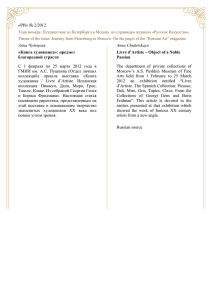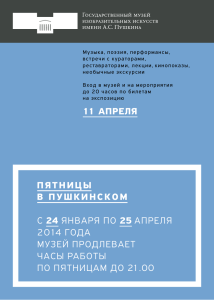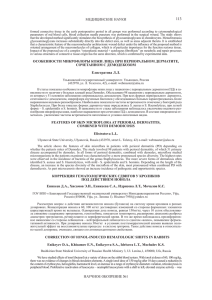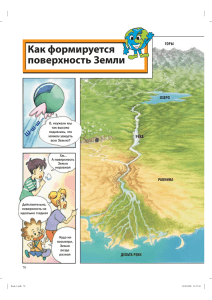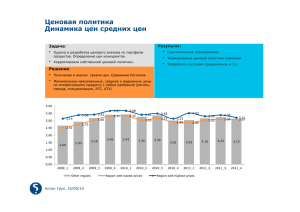Книга художника – Livre d`artiste
реклама
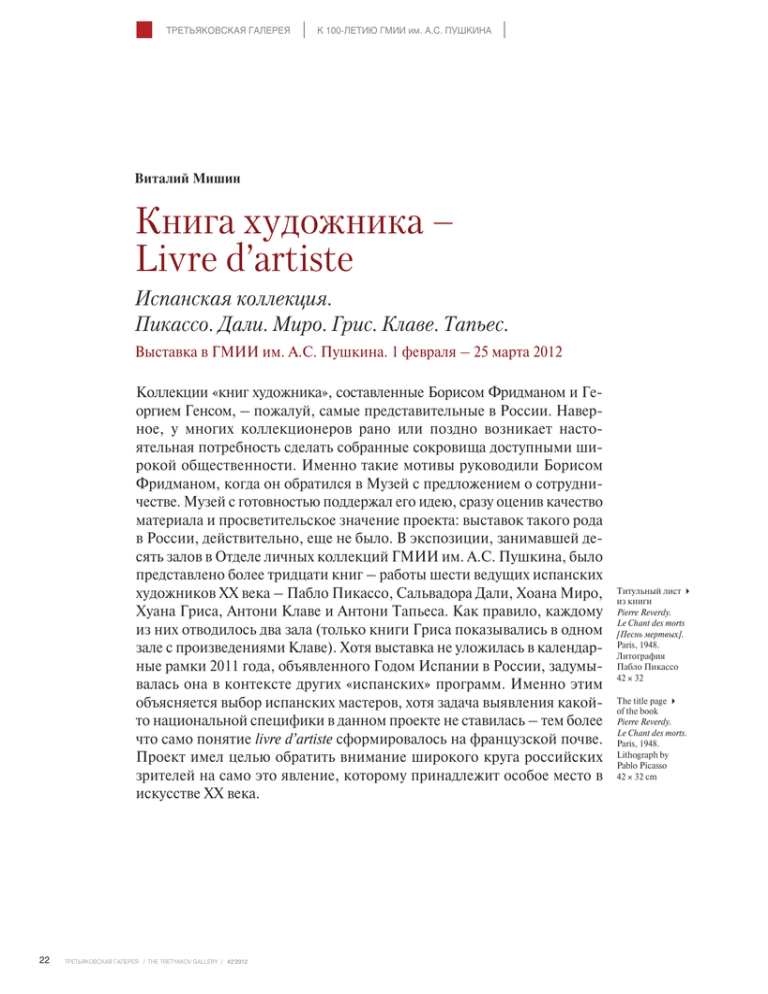
ТРЕТЬЯКОВСКАЯ ГАЛЕРЕЯ К 100-ЛЕТИЮ ГМИИ им. А.С. ПУШКИНА Виталий Мишин Книга художника – Livre d’artiste Испанская коллекция. Пикассо. Дали. Миро. Грис. Клаве. Тапьес. Выставка в ГМИИ им. А.С. Пушкина. 1 февраля – 25 марта 2012 Коллекции «книг художника», составленные Борисом Фридманом и Георгием Генсом, – пожалуй, самые представительные в России. Наверное, у многих коллекционеров рано или поздно возникает настоятельная потребность сделать собранные сокровища доступными широкой общественности. Именно такие мотивы руководили Борисом Фридманом, когда он обратился в Музей с предложением о сотрудничестве. Музей с готовностью поддержал его идею, сразу оценив качество материала и просветительское значение проекта: выставок такого рода в России, действительно, еще не было. В экспозиции, занимавшей десять залов в Отделе личных коллекций ГМИИ им. А.С. Пушкина, было представлено более тридцати книг – работы шести ведущих испанских художников XX века – Пабло Пикассо, Сальвадора Дали, Хоана Миро, Хуана Гриса, Антони Клаве и Антони Тапьеса. Как правило, каждому из них отводилось два зала (только книги Гриса показывались в одном зале с произведениями Клаве). Хотя выставка не уложилась в календарные рамки 2011 года, объявленного Годом Испании в России, задумывалась она в контексте других «испанских» программ. Именно этим объясняется выбор испанских мастеров, хотя задача выявления какойто национальной специфики в данном проекте не ставилась – тем более что само понятие livre d’artiste сформировалось на французской почве. Проект имел целью обратить внимание широкого круга российских зрителей на само это явление, которому принадлежит особое место в искусстве XX века. 22 ТРЕТЬЯКОВСКАЯ ГАЛЕРЕЯ / THE TRETYAKOV GALLERY / #2’2012 Титульный лист 4 из книги Pierre Reverdy. Le Chant des morts [Песнь мертвых]. Paris, 1948. Литография Пабло Пикассо 42 ¥ 32 The title page 4 of the book Pierre Reverdy. Le Chant des morts. Paris, 1948. Lithograph by Pablo Picasso 42 ¥ 32 cm К 100-ЛЕТИЮ ГМИИ им. А.С. ПУШКИНА Разворот из книги Pierre Reverdy. Au Soleil du plafond Paris, 1955 Цветная литография Хуана Гриса 42 ¥ 64 A double-page spread from the book Pierre Reverdy. Au Soleil du plafond Paris, 1955. A colour lithograph by Juan Gris 42 ¥ 64 cm 24 ТРЕТЬЯКОВСКАЯ ГАЛЕРЕЯ / THE TRETYAKOV GALLERY / #2’2012 отя русский термин «книга художника», как и английский artist’s book, представляют собой точную кальку с французского livre d’artiste, на самом деле они не тождественны. То, что называется livre d’artiste, безусловно, относится к жанру «книга художника», но не всякую «книгу художника» можно определить как livre d’artiste. В русской и английской традиции термин указывает, в первую очередь, на значение «инвенции», то есть концептуального начала в создании книги, носителем которого является художник (имеется в виду, концепция взаимодействия текста и изображения). Во французском языке понятие livre d’artiste тоже несет в себе этот смысл, но сверх того предполагает особые требования, предъявляемые к материальному воплощению замысла, некоторые признаки, отличающие так называемые «роскошные» библиофильские издания (éditions de luxe), или то, что англичане называют fine printing. Чтобы точнее определить предмет выставки, в ее названии и связанных с ней информационных материалах используется двойной русско-французский термин: «книга художника – livre d’artiste». Важнейший признак, отличающий книги такого рода, – использование оригинальных техник печатной графики: резца, офорта, сухой иглы, акватинты, ксилографии, литографии Х (впрочем, изредка в эту сферу допускается и фотография). Иногда они дополнялись тиснением, раскраской по трафарету, коллажем и другими приемами, придающими книге уникальный характер. Издания принципиально малотиражны: обычно несколько сот, часто – несколько десятков экземпляров. Такие книги, как правило, не сброшюрованы, они составляются из отдельных, свободно сложенных листов, заключенных в футляр или коробку. Особое внимание уделяется качеству бумаги и печати; нередко разные части тиража печатаются на бумагах разных сортов; часто используется бумага ручного отлива, с необрезанными краями. Шрифт играет роль важнейшего формообразующего элемента; нередко воспроизводятся рукописные тексты автора или художника, что еще более подчеркивает рукотворный характер издания. Важные художественные факторы – пропорции между текстом и полями в пределах страницы; общий вид каждого разворота; равновесие или, во всяком случае, эстетически осмысленное соотношение между темным и светлым, между шрифтом или изображением – и фоном бумаги. Чаще всего ведущая роль в определении эстетического облика книги в целом (а не только блока собственно иллюстраций) принадлежала художнику. Художники, работавшие в этом жанре, К 100-ЛЕТИЮ ГМИИ им. А.С. ПУШКИНА Разворот из книги Joseph Brodsky. Romische Elegien (Римские элегии) Switzerland, St. Gallen, 1993 Литография Антони Тапьеса 36,5 ¥ 57 A double-page spread from the book Joseph Brodsky. Romische Elegien (Римские элегии) Switzerland, St. Gallen, 1993 Lithograph by Antoni Tàpies 36.5 ¥ 57 cm не были специалистами-иллюстраторами в традиционном смысле слова, подчас они вообще не ставили перед собой задачу интерпретации текста; в любом случае, они были очень далеки от того, чтобы просто «визуализировать» фабулу литературного произведения. Они создавали особого рода художественный объект. Однако успех зависел от взаимопонимания всех участников проекта – не только от художника, но и от автора текста (если речь шла о современнике и он был вовлечен в дело), от издателя, от печатника. В каждом конкретном издании роли между ними распределялись по-разному; иногда в одном лице совмещались разные функции (например, художник использовал тексты собственного сочинения). В лучших образцах этого жанра единая художественная воля пронизывает все конструктивные элементы книги, превращая ее в некое синтетическое произведение искусства. То, что называется «авторская книга», – от начала до конца плод труда одного человека – частный случай «книги художника», явление, получившее широкое распространение ближе к концу XX века. В принципе, любой текст мог стать основой для создания livre d’artiste – будь то сочинение никому неведомого автора, общеизвестный литературный памятник или текст самого художника. Но для истории жанра в первые десятилетия XX века особый интерес представляют случаи активного участия в издательских проектах современных писателей и поэтов, принадлежавших к тому же кругу артистического авангарда, что и художники (Гийом Аполлинер, Андре Бретон, Поль Элюар и другие). Именно в этой литературно-художественной среде Парижа формировалась эстетика livre d’artiste. Но важную миссию выполнял и издатель, от которого исходил заказ на работу: иногда именно он задавал основные параметры будущей книги, брал на себя разработку ее дизайна (имеется в виду разработка общей структуры, определение состава и характера книжных украшений и иллюстраций, выбор шрифтов и т.п.); недаром на каждом экземпляре обычно стоят две подписи – и художника, и издателя. Для сложения особых «правил жанра» livre d’artiste имело значение то обстоятельство, что инициаторами первых книг такого рода оказались не профессиональные издатели, а торговцы произведениями искусства, проявлявшие интерес к издательской деятельности. Речь идет, в первую очередь, об Амбруазе Волларе и Даниэле-Анри Канвейлере. Они стремились предоставить дополнительное поле деятельности мастерам, с которыми имели дело в качестве маршанов, и тем самым способствовать их известности. Сначала Воллар попробовал заказывать эстампы не профессиональным граверам, а живописцам, осваивавшим техники печатной графики. Позднее он обратился к живописцам в связи со своими проектами издания книг. При этом он действовал в обход «специалистов» – графиков-иллюстраторов и наперекор сложившемуся стандарту библиофильских изданий. Издательская карьера Амбруаза Воллара началась в 1900 году с книги Paul Verlaine, Parallèlement с литографиями Пьера Боннара. Это издание, вышедшее тиражом двести с небольшим экземпляров, стало во многих отношениях эталоном жанра. Livre d’artiste, как некая драгоценная вещь, была рассчитана на то, чтобы брать ее в руки, неторопливо перекладывать страницы, осязать фактуру бумаги (хотя в музеях принято пользоваться специальными перчатками). Некоторые владельцы таких книг совершают непростительное насилие над их природой, отдавая несброшюрованные листы в переплет, пусть даже ремесло переплетчика достигает уровня настоящего искусства. Но, с другой стороны, не нарушаем ли мы естественную форму существования этих книг, когда показываем на стенах по отдельности извлеченные из них листы? Строго говоря, нарушаем. Но все же у такого способа экспонирования есть одно неоспоримое преимущество – возможность ТРЕТЬЯКОВСКАЯ ГАЛЕРЕЯ / THE TRETYAKOV GALLERY / #2’2012 25 К 100-ЛЕТИЮ ГМИИ им. А.С. ПУШКИНА охватить все содержимое книги одним взглядом. То, что обычно существует в сжатом, компактном, виде вдруг разворачивается перед нами с поразительной наглядностью и блеском. Говоря о livre d’artiste как о «синтетическом произведении искусства», мы имели в виду некую идеальную модель такого объекта. На практике степень «интегрированности», «сплавленности» отдельных элементов книжного оформления заметно варьируется в разных изданиях. Нередко генетическая связь иллюстраций со станковой графикой достаточно хорошо просматривается, иной раз она даже намеренно подчеркивается. Мы имеем в виду издания, где гравюры или литографии присутствуют одновременно в двух формах – разрозненно внутри самой книги как украшение текста и в виде единой сюиты, которая служит неким приложением. Такими приложениями снабжалась обычно лишь часть тиража, приобретавшая в силу этого эксклюзивный характер. Сюита могла быть издана в виде отдельной папки и более ограниченным тиражом; так произошло с офортами Пикассо к книге Aristophanes, Lysistrata (1934). В экспозиции на стене одного из залов можно было видеть и листы, извлеченные из такой папки (с необрезанными полями и подписанные художником), и саму книгу, выставленную в витрине. Оформленное Клаве издание Alexandre Pouchkine, La Dame de Pique (1946) включает дополнительную сюиту литографий в тоне сепии (в самой книге они черно-белые) и варианты к некоторым 26 литографиям; причем эти дополнительные листы содержат так называемые «ремарки» – разного рода наброски на полях основного изображения, придающие книге в еще большей степени характер раритета. Такую же роль играет оригинальный рисунок, вложенный в экземпляр другой книги Клаве – Prosper Merimée, Carmen (1946). Однако экспозиционеры старались по возможности показывать в сопутствующих витринах коробки, футляры и обложки – как напоминание о том, что мы всё-таки имеем дело с книгой, а не со станковой графикой. В качестве примера издания, в котором невозможно разделить работу «иллюстратора» в узком смысле слова и работу дизайнера, можно назвать книгу Клаве François Rabelais, Gargantua (1955): все части, составляющие ее «архитектуру», – цветные литографии (двух- и одностраничные или размещенные в тексте), ксилографические буквицы и концовки, шрифтовой набор – образуют нераздельное целое, подчиненное замыслу одного человека – художника. Другой пример издания, в котором художник был полновластным хозяином, – книга Pablo Picasso, Poèmes et Lithographies (1954), вышедшая в издательстве Galerie Louise Leiris: здесь Пикассо отвечал за все ее составляющие: он был автором текстов, причем написанных его рукой; он же выполнил рисунки и скомпоновал все страницы альбома, находя каждый раз какое-то новое соотношение между изображением и рукописным текстом. Еще один ТРЕТЬЯКОВСКАЯ ГАЛЕРЕЯ / THE TRETYAKOV GALLERY / #2’2012 образец такого рода – книга Миро Le Lézard aux Plumes d’or (1971), в которой цветные литографии художника перемежаются со страницами, заполненными текстом, автором которого является сам Миро; при этом написанный им от руки текст представляет собой памятник каллиграфии, обладающий самостоятельной, чисто графической выразительностью. Кстати заметим, что когда художник имел дело не со своим, а с чужим текстом, он все равно нередко предпочитал его рукописное начертание: так, в книге Pierre Reverdy, Le Chant des Morts (1948) Пикассо воспроизводит рукописный текст Реверди, Тапьес в книге Joseph Brodsky, Romische Elegien (1993) использует автографы Бродского, Миро в книге Jacques Prévert, Adonides (1975) – соответственно автографы Превера и т. д. Хотя экспонаты на выставке были распределены по художникам, ее можно было осваивать и иными путями, руководствуясь собственным планом. Например, можно было «пройтись» по издателям. Экспозиция давала повод говорить о таких выдающихся фигурах, как Амбруаз Воллар, Даниэль-Анри Канвейлер, Илья Зданевич, Териад, Эме Маг, Альбер Скира. Представленная на выставке книга Honoré de Balzac, Le Chef-d’Oeuvre inconnu с иллюстрациями Пикассо есть в большой мере результат издательского выбора, она частью составлена на материале рисунков художника 20-х годов, изначально не связанных с изданием и отобранных Волларом из старых альбомов и порт- Разворот из книги Hélène Baronne d’Oettingen (Roch Grey). Chevaux de minuit [Полуночные кони] Cannes/Paris, 1956 Гравюра (сухая игла) Пабло Пикассо 31 ¥ 62 A double-page spread from the book Hélène Baronne d’Oettingen (Roch Grey). Chevaux de minuit Cannes/Paris, 1956 Drypoint print by Pablo Picasso 31 ¥ 62 cm К 100-ЛЕТИЮ ГМИИ им. А.С. ПУШКИНА Титульный разворот из книги Lewis Carroll. Alice’s Adventures in Wonderland [Алиса в стране чудес] New York, 1969 Гравюра на фронтисписе (цветной офорт) Сальвадора Дали 43 ¥ 57 A double-page spread with the title page from the book Lewis Carroll. Alice’s Adventures in Wonderland New York, 1969 A print (colour etching) on the frontispiece by Salvador Dali 43 ¥ 57 cm фолио мастера. Особый интерес для российского зрителя имеют книги, изданные Ильей Зданевичем – Ильяздом. Художник, критик, поэт, пропагандист русского футуризма, Зданевич после переезда во Францию в 1921 году продолжал заниматься издательской деятельностью. На выставке показывались шесть его книг с гравюрами, специально выполненными для этих изданий Пикассо, и одна – с иллюстрациями Миро. Зданевич проявлял большую инициативу в выборе и отыскании текстов. Начать с того, что в случае с его первой книгой в жанре livre d’artiste он сам выступил в качестве автора, предложив Пикассо, с которым он подружился в 1922 году, дополнить его сонеты рядом гравюр: так появилась книга Afat (1940). В иных случаях Зданевич находил сочинения малоизвестных авторов (Adrien de Monluc, La Maigre, 1952; Marcos Jimenes de la Espada, Le Frère Mendiant, 1959), словно желая подчеркнуть, что книга как предмет искусства может представлять интерес даже просто в силу своих изобразительно-художественных и типографских качеств. Некоторые проекты Зданевича дают пример особенно активной, творческой роли издателя в конструировании книги. Очень наглядно это проявляется в издании Hélène Baronne d’Oettingen, Chevaux de Minuit (1956), где элементы типографского набора размещены в ритмическом соответствии с иллюстрациями Пикассо. Издатель и он же дизайнер книги выступает здесь на равных правах с художником. Зданевич придавал исключительное значение характеру шрифта, расстоянию между буквами и между строками, от которого зависело общее впечатление легкости, прозрачности страницы. Порой «конструктивистские» эксперименты Зданевича со шрифтовым набором, «эстетизация» шрифта заходили довольно далеко: так, в книге Adrian de Monluc, Le Courtisan grotesque с офортами Миро (1974) он местами укладывает буквы на бок, что, конечно, затрудняет чтение текста, зато необычайно обостряет восприятие шрифта как самоценного элемента графики. На выставке можно было наблюдать очень широкий спектр технических и изобразительных средств, к которым прибегали художники книги. Экспозиционеры местами обыгрывали контрастные решения: так, экспонаты в первом зале, где были выставлены книги, созданные Пикассо в сотрудничестве со Зданевичем, – это строго черно-белая графика, построенная преимущественно на выразительности очеркового офорта или сухой иглы; в ней много воздуха и света. В соседнем зале, что по правую руку от входа, тоже показывались работы Пикассо, но здесь в центре главной стены горел интенсивный красный цвет – это листы из книги Pierre Reverdy, Le Chant des Morts, в которых художник набросал широкой кистью абстрактные формы, похожие на иероглифы и как будто свободно скользящие поверх рукописного текста. Зритель, пожелавший из первого зала пойти не направо, а прямо, попадал в фантастический мир Миро; и здесь, тоже по контрасту с предыдущим залом, царил цвет – цветные гравюры Миро на фоне белых стен сияли наподобие витражей. В листах из книги Jacques Prévert, Adonides художник использовал среди прочего тиснение, создающее в изображении как бы дополнительное измерение. Особенно изощренные фактурные эффекты применял в своих книгах Тапьес; впрочем, они не были для него самоцелью, но создавали особую завораживающую поверхность, распола- ТРЕТЬЯКОВСКАЯ ГАЛЕРЕЯ / THE TRETYAKOV GALLERY / #2’2012 27 К 100-ЛЕТИЮ ГМИИ им. А.С. ПУШКИНА Разворот из книги Adrian de Monluc. Le Courtisan grotesque [Гротескный куртизан]. Paris, 1974 Гравюра (цветной офорт с акватинтой) Хоана Миро. 44 ¥ 58 A double-page spread from the book Adrian de Monluc. Le Courtisan grotesque. Paris, 1974 A print (colour etching with aquatint) by Joan Miro 44 ¥ 58 cm 28 ТРЕТЬЯКОВСКАЯ ГАЛЕРЕЯ / THE TRETYAKOV GALLERY / #2’2012 К 100-ЛЕТИЮ ГМИИ им. А.С. ПУШКИНА Разворот из книги Joan Miro. Le Lézard aux plumes d’or [Ящерица с золотыми перьями] Paris, 1971 Цветная литография Хоана Миро 35 ¥ 100 A double-page spread from the book Joan Miro. Le Lézard aux plumes d’or Paris, 1971 A colour lithograph 35 ¥ 100 cm гающую к медитации и созерцанию; некоторые листы заставляют вспомнить дальневосточное искусство. Дали прибегал для воплощения своих сюрреалистических видений к самым разнообразным техникам, охотно смешивая их друг с другом. Особую изобретательность он проявил в «конструировании» своих книг: издание Salvador Dali, Dix recettes d’immortalité (1973) отличается, помимо экстравагантной коробки, наличием двух офортов в виде объектов – раскладывающейся в пространстве бумажной конструкции. Будущее показало, что развитие жанра «книги художника» пойдет именно по этому пути – по пути превращения книги в объект, все более отдаляющийся от гутенберговского прообраза. Пример того, как книга обретает дополнительное, звуковое, измерение – работа Тапьеса Joseph Brodsky, Romische Elegien: ее экспонирование сопровождалось записью голоса Иосифа Бродского, читающего свои «Римские элегии» (CD-диск входит в состав издания). На фоне выставки был проведен «круглый стол» – «Книга художника: границы явления» (ГМИИ им. А.С. Пушкина, 15 марта 2012). В нем участвовали известные художники, работающие в этом жанре, искусствоведы, филологи, издатели, работники библиотек, коллекционеры, галеристы. Разговор о «границах явления» – это неизбежно и разговор о терминах. Обсуждение показало, что русская терминология в данной области еще не вполне устоялась, и хотя «круглый стол» в ГМИИ им. А.С. Пушкина не мог радикально изменить эту ситуацию, сама постановка проблемы должна принести какую-то пользу. Констатировалось, что стандарты livre d’artiste, сложившиеся в первой половине XX века, утратили свою обязательность к концу столетия и даже раньше, но «книга художника» в широком смысле этого понятия продолжает развиваться и остается областью эксперимента, авторского «жеста», не признающего никаких правил. Во многих выступлениях прозвучало сожаление по поводу того, что в России, в отличие от многих других стран, «книга художника» как вид искусства не пользуется вниманием, какого заслуживает. Государственные музеи и библиотеки прилагают явно недостаточно усилий по комплектованию фондов материалом такого рода или вообще игнорируют его. Весьма узок круг частных коллекционеров, интересующихся «книгой художника»; деятельность Б. Фридмана и Г. Генса выглядит скорее как исключение, особый случай. Между тем время работает против нас, ресурсы художественного рынка быстро истощаются. Но, несмотря на общую пессимистическую оценку положения дел в этой сфере, есть надежда, что призывы участников конференции будут услышаны. Сам факт проведения такой конференции – позитивное явление, одно из свидетельств того, что выставка в ГМИИ им. А.С. Пушкина вызвала общественный резонанс. ТРЕТЬЯКОВСКАЯ ГАЛЕРЕЯ / THE TRETYAKOV GALLERY / #2’2012 29 THE TRETYAKOV GALLERY ON THE 100th ANNIVERSARY OF THE PUSHKIN FINE ARTS MUSEUM Vitaly Mishin Livre d’Artiste: The Spanish Collection – Picasso, Dalí, Miró, Gris, Clavé, Tàpies, at the Pushkin Fine Arts Museum The collections of artists’ books amassed by Boris Friedman and George Gens are probably the fullest of their kind in Russia. There comes a point in the life of many collectors when they feel the urge to make the riches at their disposal available to the public. Such were the motives of Friedman, when he approached the Pushkin Fine Arts Museum with a suggestion for cooperation. The museum was pleased to accept: the material on offer was of extremely high quality, and such projects have undoubted educational value. On show from February to the end of March 2012, it was the first an exhibition of its kind in Russia. aking up ten rooms in the private collections department of the museum, the exhibition showcased more than 30 books by six leading 20th-century Spanish artists: Pablo Picasso, Salvador Dalí, Joan Miró, Juan Gris, Antoni Clavé and Antoni Tàpies. Most artists were allocated two rooms, with Gris and Clavé sharing a room. 2011 marked the “year of Spain in Russia”, and although the exhibition did not formally open in that year, it was nevertheless planned as one of the special Spanishthemed events. Hence the choice of Spanish masters, although the organizers did not attempt specifically to examine national traits in the works on display. The concept of the livre d’artiste was, of course, born in France. The aim of the project was to draw the attention of the broad Russian art-loving public to this special phenomenon, which occupies a unique place in 20th-century art. Although the Russian term kniga khudozhnika, like the English “artist’s book” is, it seems, a calque from the French livre d’artiste, there are differences in usage. The livre d’artiste is always a kniga khudozhnika, yet an artist’s book in the Russian sense is not always a livre d’artiste. In Russian and English, the term indicates the primary importance of the artist’s imaginative view, of his or her conception of the interaction between images and text. The French term livre d’artiste possesses the same connotations, whilst also implying a particular approach in the realization of the artist’s concept – certain traits, typical of so-called éditions de luxe, or fine T Лист из книги 4 Johann Wolfgang von Goethe. Faust [Фауст] Geneva, 1969 Гравюра (офорт, сухая игла) Сальвадора Дали 38 ¥ 28 A page from the book4 Johann Wolfgang von Goethe. Faust Geneva, 1969 Print (etching, drypoint) by Salvador Dali 38 ¥ 28 cm 30 ТРЕТЬЯКОВСКАЯ ГАЛЕРЕЯ / THE TRETYAKOV GALLERY / #2’2012 printing. In order more clearly to define the object of this exhibition, its name, and in all supplementary material the double Russian-French term is used. A trait typical of livres d’artistes is the use of original printing techniques such as engraving, etching, drypoint, aquatint, xylography and lithography. Occasionally, photography is used. These methods can be supplemented with stamping, stenciling, collage and other techniques emphasizing the book’s uniqueness. Livres d’artistes are usually published in small editions of several hundred or, in many cases, several dozen copies. Rather than being stitched, they are most often made up of separate sheets stacked in a case or box. Particular attention is given to the quality of the paper and printing, with different parts often printed on different types of paper. Handmade paper with uneven edges is often used. The typeface is also crucial in setting the style: sometimes, hand-written texts by the author or artist are reproduced, highlighting the “handmade” impression. How much space the text occupies on a page, the general view of each double-page spread, the aesthetic balance between light and dark patches, the proportion of images to text, and the relationships between text, image and background – all are given the most careful consideration. The artist was most often responsible not only for the illustrations, but for the overall aesthetic image. The artists working on such projects were not in fact illustrators per se; their aim was not so much to inter- pret the text, producing artistic images to reflect the words, but to create a special object of art. A project’s success, however, depended on the degree of understanding between all of its participants. Besides the artist, these included the author of the text (provided he or she was living, and involved in the work), the publisher and the printer. The roles of each party would differ depending on the project. Sometimes, the same person might take on several functions: artists, for instance, might work with texts they themselves had written. In the best examples of such books, all elements are born of a single artistic vision, and together produce a single synthetic work of art. A particular type of artist’s book – that created entirely by one person – became common in the late 20th century. In principle, a livre d’artiste can be created around any text, be it a famous literary masterpiece, a work by a little-known author, or something written by the artist. Yet in the first few decades of the 20th century, the most interesting examples of livres d’artistes were perhaps those combining text by contemporary writers and poets (such as Guillaume Apollinaire, André Breton or Paul Eluard), with images by artists from the same avant-garde circles. In this Parisian literary and artistic milieu, the aesthetics of the livre d’artiste took shape. The publisher placing the order for any such livre d’artiste, could also exert an important influence on the end product. In many cases, publishers determined the ON THE 100th ANNIVERSARY OF THE PUSHKIN FINE ARTS MUSEUM Лист из книги Pablo Picasso. Poèmes et Lithographies [Пабло Пикассо. Поэмы и литографии] Paris, 1954 Литография Пабло Пикассо. 65 ¥ 50 32 A page from the book Pablo Picasso. Poèmes et Lithographies Paris, 1954 Lithograph by Pablo Picasso. 65 ¥ 50 cm ТРЕТЬЯКОВСКАЯ ГАЛЕРЕЯ / THE TRETYAKOV GALLERY / #2’2012 ON THE 100th ANNIVERSARY OF THE PUSHKIN FINE ARTS MUSEUM Разворот из книги François Rabelais. Gargantua [Гаргантюа] Toulon, 1955 Цветная литография Антони Клаве 38 ¥ 56 A double-page spread from the book François Rabelais. Gargantua Toulon, 1955 A colour lithograph by Antoni Clavé 38 ¥ 56 cm edition’s design and main characteristics, deciding on the general structure, style and subjects of the decoration and illustrations, the typeface and other such matters. Indeed, most books were signed by the publisher, as well as the artist. An interesting and significant detail in the history of the livre d’artiste is that the first such books appeared thanks to art dealers with an interest in publishing, not professional publishers. The most notable figures in this regard are Ambroise Vollard and Daniel-Henry Kahnweiler. As art dealers, they strove to create new opportunities for the painters whose works they sold, in order to make them better-known. Vollard had in the past favoured artists studying printing over professional printmakers to commission plates. He later approached painters with ideas for producing original books, similarly bypassing the “specialists” – graphic artists and illustrators, thus flaunting accepted practice for bibliophile editions. Vollard’s publishing career began in 1900 with Paul Verlaine’s “Parallèlement”, which contained lithographs by Pierre Bonnard. Published in an edition of just over 200 copies, the book in many ways set the standards for the genre. Livres d’artistes are precious things, to be handled with care. Readers would pick them up lovingly, slowly perusing page after page, fingering the texture of the paper. (Though in museums, visitors were given special gloves so as not to damage the books.) Certain fortunate owners of livres d’artistes chose, however, to violate the very nature of these unique publications by having them bound, albeit by skilled bookbinders. That said, did we ourselves not break up the natural state of the livres d’artistes by displaying their pages separately on the walls of an exhibition space? It could certainly be argued that we did. At the same time, this method of display has the undeniable advantage of simultaneously offering the viewer all of the book’s contents. The story, previously encased in compact form, suddenly unfolds with striking clarity and impact. In referring to the livre d’artiste as a synthetic work of art, we perhaps implied an ideal model – the perfect execution of such a project. In reality, the degree of harmony and integration between the different elements of such books varied enormously. In many cases, one is aware of the illustrations’ “genetic” link to nonillustrative easel art – frequently, this link is deliberately accentuated. This is, of course, the case with editions, in which prints are present in two forms: within the book as decoration, and as an extra appended set. Such sets would not be available with all copies of a book; thus, those boasting them became even more exclusive. The supplement could be published as a separate folder with fewer copies, as was the case with Picasso’s hors-texte etchings for Aristophanes’ “Lysistrata” (1934). In the exhibition, these signed etchings with untrimmed edges were displayed on the wall in one of the rooms, the book itself shown alongside in a display case. The 1946 edition of a French translation of Pushkin’s “La Dame de Pique” (The Queen of Spades) includes a set of separate sepia lithographs by Clavé (those within the text are black and white), as well as variations on some of the plates. The hors-texte plates also contain sketches made beside the main images, rendering the edition even rarer. The original drawing by Clavé in Mérimée’s “Carmen” (1946) has the same effect. The organizers of the ТРЕТЬЯКОВСКАЯ ГАЛЕРЕЯ / THE TRETYAKOV GALLERY / #2’2012 33 ON THE 100th ANNIVERSARY OF THE PUSHKIN FINE ARTS MUSEUM exhibition attempted to display the boxes, cases and covers alongside the livres d’artistes themselves, to remind visitors that they are admiring books – not merely separate works of art. Clavé’s 1955 edition of “Gargantua” by François Rabelais is perhaps an example of a livre d’artiste in which the work of the “illustrator” and that of the designer can scarcely be distinguished from each other. The single- and double-page colour lithographs, as well as those within the text; the large xylographic initial capitals and tailpieces; the typeface – all come together as one to create a single effect, orchestrated by a single person – the artist. Another example of a livre d’artiste, in which the artist had overall control, is Picasso’s “Poèmes et Lithographies” (1954) published by the Galerie Louise Leiris. Picasso was responsible for all the book’s components: the author of the texts, which are presented handwritten, he also produced the accompanying images and set out the pages, finding for each its own unique relationship between image and text. Another such example is Miró’s “Le Lézard aux Plumes d’Or” (1971). Here, the artist’s colour lithographs alternate with pages filled with text. Written by Miró himself, the text is an outstanding piece of calligraphy: a work of art in itself, it is strikingly expressive. Many artists preferred working with handwritten text, even if it belonged to a different author. Thus, in “Le Chant des Morts” (1948), Picasso offers Pierre Reverdy’s poetry hand-written; in Joseph Brodsky’s “Romische Elegien” (1993) Tàpies reproduces the poet’s autograph; and Miró does the same in Jacques Prévert’s “Adonides” (1975). Although the books were displayed by artist, one could have viewed the exhibition in different ways, for instance, by publisher. The display brought up the names of outstanding figures such as Ambroise Vollard, Daniel-Henry Kahnweiler, Ilya Zdanevich, Tériade, Aimé Maeght and Albert Skira. Balzac’s “Le Chef-d’Oeuvre Inconnu” (1931), one of the books on display, is largely the product of its publisher’s decisions, for instance. To go with the text, Vollard chose 1920s drawings by Picasso, which initially had nothing to do with the work: the images were selected from Picasso’s old albums and portfolio. For Russian visitors, the books published by Zdanevich, also known as “Iliazd”, were of particular interest. Artist, art critic, poet and proponent of Russian Futurism, in 1921 Zdanevich moved to France, where he continued his publishing activity. The exhibition includes six books published by Iliazd with etchings made especially by Picasso, and one with illustrations by Miró. Zdanevich took great interest in seeking out and choosing the texts for his books. For his first livre d’artiste he used his own, approaching Picasso, whom he had met in 1922, with a suggestion that the artist create a series of etchings to accompany his 34 sonnets. Thus, “Afat” (1940) was born. On other occasions, Iliazd chose works by little-known authors, such as Adrien de Monluc’s “La Maigre” (1952) or Marcos Jimenes de la Espada’s “Le Frère Mendiant” (1959), as if to underline that a book may become a work of art by dint of its artistic appearance and high-quality typography. Certain projects undertaken by Iliazd offer particularly striking examples of the publisher’s active creative role in designing the books and putting them together. Héléne, Baronne d’Oettingen’s “Chevaux de Minuit” (1956) is one such example. The typeface chosen for this edition develops its own rhythmic relationship with Picasso’s illustrations. The publisher, who is ТРЕТЬЯКОВСКАЯ ГАЛЕРЕЯ / THE TRETYAKOV GALLERY / #2’2012 also the designer, shapes the project just as much as does the artist. Zdanevich paid particular attention to the typeface and distances between lines and letters, through which a page could “breathe”, creating an impression of airiness and space. At times, Zdanevich’s “Constructivist” and aesthetic experiments with typesetting could be quite extreme. In Adrian de Monluc’s “Le Courtisan Grotesque” (1974), illustrated with etchings by Miró, Iliazd places some letters on their sides. While making the text a little harder to read, this does make the reader superbly aware of the artistic potential of print. The exhibition allowed visitors to appreciate the remarkably diverse range of Разворот из книги Jacques Prévert. Adonides. Paris, 1975 Гравюра (офорт с акватинтой) Хоана Миро 39,5 ¥ 66 A double-page spread from the book Jacques Prévert. Adonides. Paris, 1975 A print (etching with aquatint) by Joan Miro 39.5 ¥ 66 cm ON THE 100th ANNIVERSARY OF THE PUSHKIN FINE ARTS MUSEUM technical and artistic methods employed by the artists. The display itself was planned to maximum effect: in the first room, containing the books created by Picasso with Zdanevich, one was met with striking black and white graphic art: etching and drypoint combine to create a light, airy effect. The room next door, to the right of the entrance, also contained works by Picasso, but the prevailing colour here was red. Displayed in the centre of the main wall, pages from Pierre Reverdy’s “Le Chant des Morts” burned with an intense sanguine. The abstract forms created by Picasso with a wide brush are like hieroglyphs, floating freely over the handwritten text. Those who chose to continue straight on out of the first room without turning right, found themselves in the fantastic world of Miró. Like the glowing red of the Reverdy, the brilliant colour here contrasts dramatically with the reserved black and white of the first space. Vivid prints by Miró stand out from the white walls like stained glass windows. In Jacques Prévert’s “Adonides” (1975), Miró uses the technique of stamping, which has the effect of creating an extra dimension to the images. Perhaps the most complex textural effects, however, are to be found in the books by Antoni Tàpies. Although the artist did not pursue these as an aim in themselves, they serve to create a unique, bewitching surface, conducive to contemplation and deep thought. Certain pages are reminiscent of Far-Eastern art. Salvador Dalí used a range of diverse techniques to put across his Surrealist vision, frequently combining them with startling effect. In putting together his livres d’artiste, he displayed particular inventiveness. Besides its extravagant case, his “Dix Recettes d’Immortalité” (1973), for instance, boasts two etchings that can be set up as “objects”, or unfolding paper constructions. The subsequent development of the livre d’artiste showed that this was, in fact, the future of the genre: becoming more like “objects”, such books would increasingly lose their resemblance to Gutenberg’s prototype. Joseph Brodsky’s “Romische Elegien” with illustrations by Antoni Tàpies, for instance, acquired the extra dimension of sound: the edition was accompanied by a CD of the poet reading his poems. Visitors entering the room where the book was on display could hear the recording. On 15 March 2012, a roundtable discussion on livres d’artistes was held at the museum, titled “The Artist’s Book: Boundaries of the Phenomenon”. The event brought together well-known artists working with this genre, as well as art historians, philologists, publishers, librarians, collectors, museum workers and gallery owners. In discussing boundaries, one inevitably turns also to discussing terms. The debate showed that Russian terminology in this area remains in flux. Naturally, one roundtable discussion could not radically alter the situation, and yet the very fact that the problem was raised should go some way to bringing about change. The standards expected of a livre d’artiste in the first half of the 20th century had largely been abandoned before its end, participants noted. Yet the artist’s book as a broad genre is still developing today – a creative experiment, a bold gesture by authors refusing to be bound by any rules. Many speakers expressed regret that in Russia, artists’ books as an art form do not receive the attention they merit, and indeed, in many countries, receive. State museums and libraries do not make enough effort to secure material of this kind or, at worst, ignore it altogether. Artists’ books are of interest to few private collectors, with Boris Friedman and George Gens undoubtedly the exception rather than the rule. And time is, sadly, not on our side, as the resources offered by the art market are dwindling fast. Despite such a pessimistic general evaluation of the situation, however, hopes remain that the call of the conference’s participants will be heard. The very fact that such an event took place should be seen as a positive sign, proving that the exhibition at the Pushkin Fine Arts Museum did trigger a public response. ТРЕТЬЯКОВСКАЯ ГАЛЕРЕЯ / THE TRETYAKOV GALLERY / #2’2012 35
